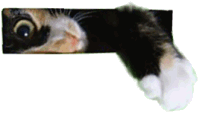Rusty-Spotted Cats
The rusty-spotted cat (Prinailurus rubiginosus) is known as ‘the hummingbird of the cat family’. If ligers are at one end of the scale, at around 500kg (1100lbs) for a heavy male, rusty-spotted cats are at the other. An average rusty-spotted female is 1/500th of the liger’s weight - just a single kilogram, with the males weighing only a half-kilo more.
The rusty-spotted cat would be the world’s smallest feline, if its body were not a few centimeters longer than the shorter but heavier black-footed cat. That small creature is described here
Black-footed and rusty-spotted cats never meet in the wild as one of these tiny wild cats is native to arid regions of sub-saharan Africa, and the other to India and Sri Lanka. Small they may be, but what they lack in size, rusty-spotted cats certainly gain with their energy.
In his 1884 book, Natural History of the Mammalia of India and Ceylon, (http://www.gutenberg.org/dirs/1/9/5/5/19550/19550-h/19550-h.htm) British naturalist Robert Armitage Sterndale described the experience with rusty-spotted cats- an experience which he shared with his own domestic cats.
"It was amusing to see the wild one dart like a squirrel up the walls of the tent on to the roof; the other [the domestic cat] would try to follow, scramble up a few feet, and then, hanging by its claws, look round piteously before it dropped to the ground."
In fact rusty-spotted cats are so at home in trees that they are described as ‘partly arboreal’, although they climb trees mainly to escape larger predators rather than to hunt. The little fellows feed mainly on rodents and birds but may also catch lizards, frogs or insects.
You can see rusty-spotted cats in motion on this video:
The rusty-spotted cat has short fur which is grey over most of the body. The rusty spots which give it its name are spread over the back and flanks. The tail is thick and relatively long (which stretches it past the black-footed cat in the tinyness stakes), and the fur is darker here so the spots are less obvious. There are distinct dark markings on each site of the face extending over the cheeks and forehead. As are other members of the feline family, rusty-spotted cats are nocturnal.
Rusty-spotted cats mate in spring and the female’s oestrus (mating season) lasts only five days. Mating is unusually brief. Since the cat is vulnerable to larger predators while mating, such brevity may be an adaptation allowing the cats to create new life while allowing the current generation to hang on to it.
A pregnant female will give birth to one or two kittens (weighing not more than 77g) after a gestation lasting just over two months. Such births hardly ever happen in captivity, so it is not surprising that The Berlin Zoo had a large celebration on the 5th of August 2012 when two rusty-spotted kittens were born. This was the first birth of these cats in the Zoo’s 168-year history.
- Prionailurus rubiginosus rubiginosus — lives in India
- Prionailurus rubiginosus phillipsi — lives Sri Lanka
Interestingly these two subspecies have adopted very different habitats. The Indian cats prefer shrubs and dry grassland, but their relatives in Sri Lanka they are found in humid mountain forests.
No-one has been able to study the cats sufficiently in the wild to determine their lifespan, but in captivity they have been reported to live for around 12 years.
Unlike other small wild cats, young rusty-spotted cats can adapt to humans and make good pets. Nineteenth century British physician and zoologist Thomas C. Jerdon kept a number of rusty-spotted cats in his home for research and this is how he described them:
"I had a kitten brought to me when very young in 1846, and it became quite tame, and was the delight and admiration of all who saw it. Its activity was quite marvellous and it was very playful and elegant in its motions." (extract from Wild Cats of the World by Swiss naturalist and writer Charles Albert Walter Guggisberg,).
However, as with many feline species, the rusty-spotted cat is threatened with extinction. According to the IUCN Red List, they’re down to 10,000 mature individuals worldwide. The cats’ limited habitat is being threatened by human expansion and logging, and humans also hunt the cats for their fur. Their number is expected to dwindle further.

